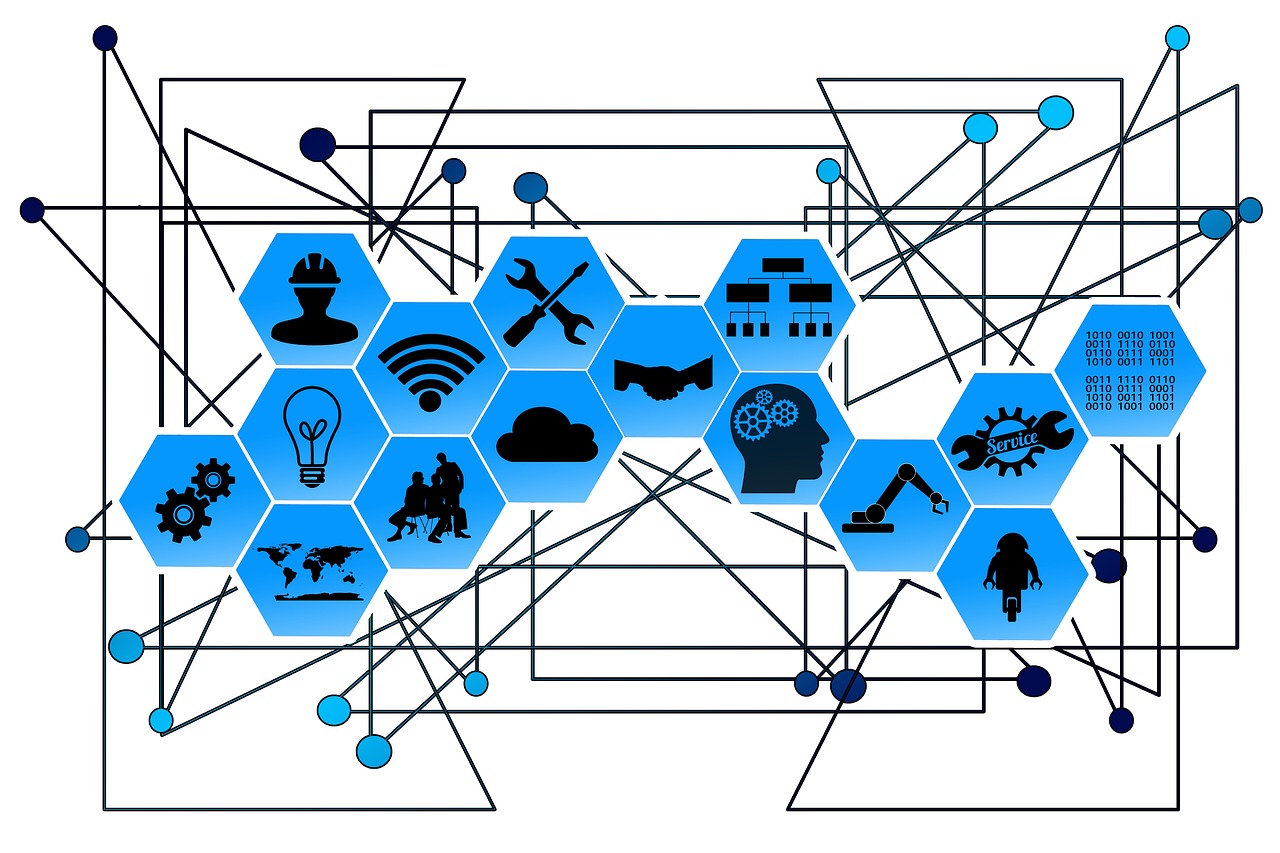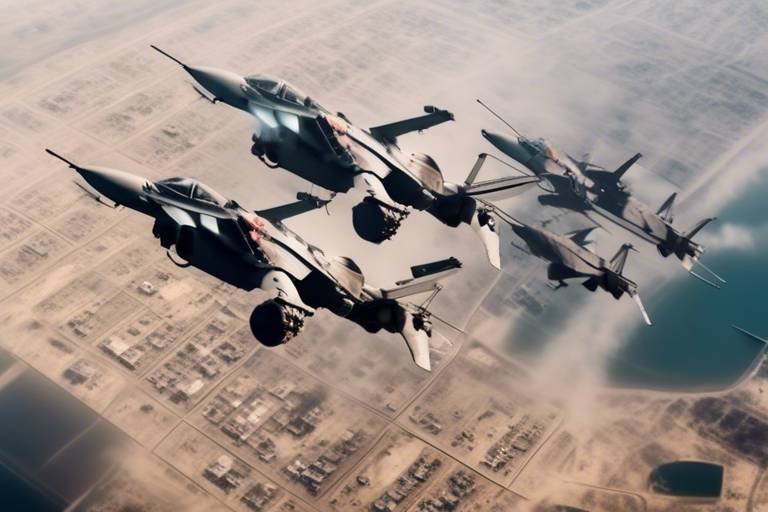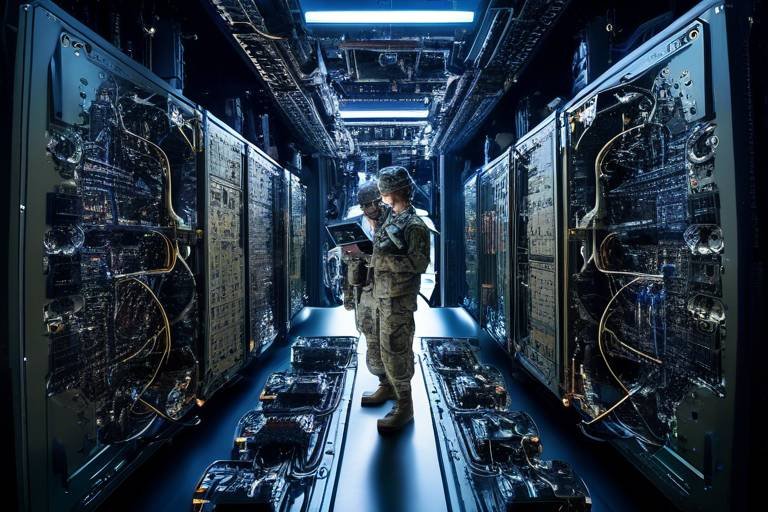AI in Precision-Guided Munitions - Revolutionizing Targeting
In the ever-evolving landscape of modern warfare, the integration of artificial intelligence (AI) into precision-guided munitions (PGMs) is nothing short of revolutionary. Imagine a world where military operations are not just about brute strength but are enhanced by advanced technology that can analyze, predict, and execute with pinpoint accuracy. This transformation is reshaping the battlefield, making it more efficient and effective than ever before. With AI at the helm, the future of targeting in military operations is not just promising; it's a game-changer.
Precision-guided munitions, often referred to as "smart bombs," have long been a cornerstone of military strategy, allowing forces to strike specific targets with remarkable accuracy. However, the introduction of AI takes this capability to unprecedented heights. By harnessing the power of machine learning and data analytics, PGMs can now assess vast amounts of information in real-time, leading to better decision-making and improved operational outcomes. This article delves into the multifaceted ways AI is revolutionizing targeting processes in PGMs, enhancing accuracy, and ultimately saving lives.
To fully appreciate the impact of AI on PGMs, it's essential to understand what these weapons are and how they have evolved over time. Precision-guided munitions are designed to hit specific targets with minimal collateral damage, making them a vital asset in military operations. The evolution of PGMs has been marked by significant technological advancements, from the early days of laser-guided bombs to today's sophisticated systems that utilize GPS and advanced sensors.
In the past, targeting was often a manual process, relying heavily on human judgment and limited data. However, as military conflicts have become more complex, the need for precision has intensified. AI addresses this challenge by providing enhanced targeting capabilities that can analyze data from multiple sources, including satellite imagery, reconnaissance reports, and real-time battlefield information. This capability not only improves the accuracy of strikes but also allows for a more strategic approach to military engagements.
AI technologies are fundamentally reshaping the targeting processes in PGMs. With the integration of machine learning algorithms, the ability to identify and select targets has become faster and more reliable. These algorithms can process enormous datasets, learning from past engagements to improve future targeting decisions. This section explores how AI is transforming the targeting landscape, making military operations more precise and efficient.
Machine learning algorithms serve as the backbone of AI in PGMs. By analyzing vast amounts of data, these algorithms can identify patterns and make predictions that were previously impossible. For instance, they can assess the likelihood of hitting a target based on various factors such as weather conditions, enemy movements, and terrain. This analysis occurs in real-time, allowing military personnel to make informed decisions quickly.
Effective data processing techniques are crucial for maximizing the potential of AI in targeting. Various methods are employed to filter and analyze data, ensuring that only the most relevant information is considered. Techniques such as natural language processing (NLP) and image recognition are used to sift through intelligence reports and visual data, respectively. This streamlined approach not only saves time but also enhances the accuracy of targeting decisions.
The ability of AI to make real-time decisions significantly impacts battlefield dynamics. In high-pressure situations, where every second counts, AI can provide critical insights that help military leaders respond swiftly to changing conditions. This capability not only improves operational efficiency but also increases the chances of mission success while minimizing risks to personnel and civilians.
Computer vision technology plays a vital role in the identification of targets. By analyzing visual data from drones and reconnaissance satellites, AI can distinguish between different objects and assess their relevance as potential targets. However, challenges remain, such as differentiating between combatants and non-combatants, which is essential for minimizing collateral damage. As AI continues to evolve, so too will its ability to navigate these complexities.
Integrating AI into PGMs offers numerous advantages that extend beyond mere technological advancements. The most significant benefits include increased accuracy and reduced collateral damage, both of which are critical in modern military operations. This section highlights these benefits in detail, illustrating how AI is not just a tool but a transformative force in warfare.
AI significantly improves the accuracy of munitions, ensuring that strikes hit their intended targets with minimal deviation. This enhancement is achieved through advanced targeting algorithms that analyze multiple data points, providing military operators with the best possible course of action. The metrics used to measure this accuracy include hit probability and target identification rates, both of which have seen substantial improvements with AI integration.
One of the most pressing concerns in military operations is collateral damage. AI helps minimize this risk by employing sophisticated targeting strategies that ensure precision in strikes. By analyzing civilian presence in target areas and adapting targeting parameters accordingly, AI-driven systems can significantly reduce the chances of unintended casualties. This capability not only protects innocent lives but also enhances the legitimacy of military operations in the eyes of the global community.
- What are precision-guided munitions?
Precision-guided munitions are advanced weapons designed to strike specific targets with high accuracy, minimizing collateral damage.
- How does AI improve targeting in PGMs?
AI enhances targeting by analyzing large datasets in real-time, improving decision-making and target identification processes.
- What are the benefits of integrating AI into military operations?
Benefits include increased accuracy, reduced collateral damage, and improved operational efficiency.
- What challenges does AI face in military applications?
Challenges include differentiating between combatants and non-combatants and ensuring data accuracy.

Understanding Precision-Guided Munitions
This article explores how artificial intelligence is transforming precision-guided munitions, enhancing targeting accuracy, and improving operational efficiency in modern warfare.
Precision-guided munitions (PGMs) are a game-changer in modern warfare, representing a significant leap from traditional unguided munitions. Imagine a world where a missile can strike a target with the precision of a surgeon's scalpel. That's the reality PGMs bring to the battlefield. They are designed to hit specific targets with a high degree of accuracy, thereby minimizing unintended damage and maximizing operational effectiveness. Over the years, these advanced weapons have evolved from simple guided bombs to complex systems that integrate cutting-edge technology.
The evolution of PGMs can be traced back to World War II, but it wasn't until the Gulf War that their true potential was realized. During this conflict, the U.S. military showcased the effectiveness of PGMs, with reports suggesting that over 80% of bombs dropped were precision-guided. This shift in military strategy underscored the importance of accuracy in combat, prompting nations worldwide to invest heavily in developing their own PGM capabilities.
So, what makes PGMs so significant? For starters, they enhance operational effectiveness by allowing military forces to engage targets with minimal collateral damage. This is crucial in modern warfare, where civilian populations often coexist with military targets. By using PGMs, militaries can achieve strategic objectives while adhering to international humanitarian laws, thus maintaining moral high ground.
Moreover, PGMs come in various forms, including guided bombs, missiles, and artillery shells. Each type is tailored for specific missions, whether it's taking out enemy installations, neutralizing armored vehicles, or striking high-value targets. The technology behind these munitions often includes GPS guidance, laser guidance, and even advanced sensors that can identify targets based on specific characteristics.
In summary, the significance of PGMs in military strategy cannot be overstated. They not only revolutionize how wars are fought but also reflect a growing commitment to precision and accountability in military operations. As we delve deeper into the role of artificial intelligence in PGMs, it becomes clear that this technology is set to redefine the future of warfare even further.
AI technologies are reshaping targeting processes in PGMs. Here, we examine how machine learning algorithms enhance target identification and selection.
Machine learning algorithms analyze vast amounts of data to improve targeting decisions. This subsection delves into their effectiveness in real-time scenarios.
Effective data processing techniques are crucial for AI in targeting. This part discusses methods used to filter and analyze data for optimal outcomes.
AI's ability to make real-time decisions enhances military responsiveness. We explore how this capability impacts battlefield dynamics.
Computer vision plays a vital role in identifying targets. This section covers its applications in PGMs and the challenges faced.
Integrating AI into PGMs offers numerous advantages, including increased accuracy and reduced collateral damage. Here, we highlight these benefits in detail.
AI significantly improves the accuracy of munitions. This subsection discusses the metrics and technologies contributing to this enhancement.
AI helps minimize collateral damage during military operations. We examine strategies employed to ensure precision in targeting while protecting civilians.
- What are precision-guided munitions?
Precision-guided munitions are advanced weapons designed to hit specific targets with high accuracy, minimizing collateral damage. - How has AI impacted military operations?
AI enhances targeting accuracy, improves decision-making processes, and increases operational efficiency in military operations. - What technologies are used in PGMs?
PGMs utilize various technologies, including GPS guidance, laser guidance, and advanced sensors for target identification. - Why is reducing collateral damage important?
Reducing collateral damage is crucial for maintaining moral high ground and adhering to international humanitarian laws during military operations.

The Role of AI in Targeting
Artificial Intelligence (AI) is not just a buzzword; it's a game-changer in the realm of precision-guided munitions (PGMs). Imagine the battlefield as a complex puzzle, where every piece must fit perfectly to ensure success. AI technologies are reshaping how we solve this puzzle, enhancing the targeting processes in PGMs like never before. With the integration of AI, military operations can now achieve unprecedented levels of accuracy and efficiency, which is crucial in modern warfare.
At the heart of this transformation are machine learning algorithms, which are designed to analyze vast amounts of data in real-time. Think of these algorithms as incredibly sharp eyes that can spot a needle in a haystack, identifying targets with pinpoint precision. They sift through data collected from various sources—satellite imagery, reconnaissance, and even social media—to make informed decisions about which targets to engage. This capability allows military strategists to focus on critical objectives while minimizing the risk of collateral damage.
Machine learning algorithms operate by learning from past data and experiences, continuously improving their targeting decisions. For example, when a particular target is successfully engaged, the algorithm records the data surrounding that event—what worked, what didn’t, and why. This iterative learning process means that the more data these algorithms process, the smarter they become. In real-time scenarios, this translates to faster and more accurate targeting decisions, drastically reducing the time it takes to engage a target.
Effective data processing techniques are crucial for AI in targeting. By utilizing advanced filtering methods, AI systems can eliminate irrelevant information and focus on the most pertinent data. For instance, a PGM equipped with AI can filter out false positives, such as civilian vehicles or decoys, ensuring that only legitimate targets are considered. This not only enhances targeting accuracy but also plays a vital role in upholding ethical standards in military operations.
The ability of AI to make real-time decisions is a significant factor that enhances military responsiveness. Imagine a scenario where a drone is on a reconnaissance mission; AI can analyze the incoming data and make split-second decisions about whether to engage a target or hold fire. This capability impacts battlefield dynamics by allowing commanders to react swiftly to changing situations, ultimately leading to more successful mission outcomes.
Another critical aspect of AI in targeting is computer vision, which plays a vital role in identifying targets. By employing sophisticated algorithms, computer vision can process images and video feeds to detect and classify objects. However, challenges remain, such as distinguishing between military targets and civilian structures. As this technology continues to evolve, it promises to enhance the effectiveness of PGMs while addressing the ethical implications of warfare.
Integrating AI into PGMs offers numerous advantages, including increased accuracy and reduced collateral damage. Here, we highlight these benefits in detail.
AI significantly improves the accuracy of munitions. This subsection discusses the metrics and technologies contributing to this enhancement.
AI helps minimize collateral damage during military operations. We examine strategies employed to ensure precision in targeting while protecting civilians.
- What are precision-guided munitions?
Precision-guided munitions (PGMs) are advanced weapons designed to hit specific targets with high accuracy, minimizing collateral damage. - How does AI improve targeting in military operations?
AI enhances targeting by analyzing vast data, improving decision-making speed and accuracy, and enabling real-time adjustments on the battlefield. - What role does machine learning play in AI targeting?
Machine learning algorithms learn from past data to make informed targeting decisions, continuously improving their accuracy over time. - What are the ethical implications of using AI in warfare?
While AI improves operational efficiency, it raises concerns about accountability, the potential for errors, and the impact on civilian populations.

Machine Learning Algorithms
Machine learning algorithms have emerged as a game-changer in the realm of precision-guided munitions (PGMs). These algorithms are designed to analyze vast datasets, enabling military systems to make informed targeting decisions with remarkable speed and accuracy. Imagine a world where weapons systems can learn from past engagements, adapt to new scenarios, and continuously improve their performance. That world is not far off, thanks to the integration of machine learning into military technology.
At the heart of this transformation is the capability of machine learning to process and interpret data in real-time. By leveraging historical data, algorithms can identify patterns and trends that human analysts might miss. For instance, when a PGM is deployed, it can analyze environmental conditions, enemy movements, and even the characteristics of the target itself. This data-driven approach not only enhances the accuracy of strikes but also reduces the time it takes to make critical decisions on the battlefield.
One of the most significant advantages of machine learning in PGMs is its ability to improve target identification. Traditional methods often rely on static parameters, which can lead to inaccuracies in dynamic combat situations. In contrast, machine learning algorithms can adapt to changing conditions, allowing for more precise targeting. For example, if a target is obscured by smoke or debris, the algorithm can utilize alternative data sources, such as infrared or radar imaging, to maintain targeting accuracy. This adaptability is crucial in modern warfare, where the battlefield is constantly evolving.
To illustrate the effectiveness of machine learning algorithms in PGMs, consider the following table showcasing key capabilities:
| Capability | Description |
|---|---|
| Real-Time Analysis | Processes data from multiple sources instantly to enhance decision-making. |
| Pattern Recognition | Identifies trends and anomalies in data that inform targeting strategies. |
| Adaptive Learning | Improves accuracy over time by learning from previous engagements. |
| Multi-Source Integration | Combines data from various sensors for comprehensive situational awareness. |
However, the integration of machine learning algorithms is not without its challenges. One of the primary concerns is the quality of data being fed into these systems. If the data is flawed or biased, the outcomes can be detrimental. Moreover, ensuring that these algorithms operate within ethical boundaries is crucial, as the stakes in military operations are incredibly high. Addressing these challenges requires a collaborative effort between data scientists, military strategists, and ethicists to create robust frameworks that govern the use of AI in warfare.
In conclusion, machine learning algorithms are revolutionizing the way precision-guided munitions operate. By harnessing the power of data, these algorithms enhance targeting accuracy, improve decision-making processes, and ultimately contribute to more effective military operations. As technology continues to evolve, the potential for machine learning in PGMs will only grow, paving the way for a new era in modern warfare.
- What are precision-guided munitions?
Precision-guided munitions are advanced weapons designed to accurately hit specific targets, minimizing collateral damage. - How does machine learning improve targeting in PGMs?
Machine learning enhances targeting by analyzing large datasets, recognizing patterns, and making real-time decisions based on current battlefield conditions. - What challenges exist with AI in military applications?
Challenges include data quality, algorithm bias, and ethical considerations regarding the use of AI in warfare. - Can machine learning algorithms adapt to new combat scenarios?
Yes, they can adapt by learning from previous engagements and adjusting their targeting strategies accordingly.

Data Processing Techniques
In the realm of precision-guided munitions (PGMs), the effectiveness of artificial intelligence (AI) hinges significantly on robust . These techniques are not just about crunching numbers; they are the backbone of how AI interprets vast datasets to make informed targeting decisions. Imagine trying to find a needle in a haystack; without the right tools, it’s nearly impossible. Similarly, without effective data processing, AI would struggle to identify and prioritize targets in the chaotic environment of modern warfare.
One of the primary data processing techniques employed in AI for PGMs is data filtering. This process involves sifting through enormous amounts of data collected from various sensors and intelligence sources to isolate relevant information. Various algorithms are designed to detect patterns and anomalies, ensuring that only the most pertinent data reaches the decision-making algorithms. For instance, when a drone is tasked with identifying a moving vehicle in a crowded urban area, filtering techniques help eliminate irrelevant data, such as static objects or unrelated movements, allowing the AI to focus on the target.
Another crucial aspect is data fusion, which combines information from multiple sources to create a cohesive picture of the battlefield. Think of it as assembling pieces of a puzzle; each piece (or data source) contributes to a clearer understanding of the overall scenario. For PGMs, this might involve integrating data from satellite imagery, ground sensors, and aerial reconnaissance to ensure that the AI has a comprehensive view of potential targets. The result is a more accurate assessment of the battlefield, leading to better-targeted strikes.
Moreover, the speed at which data is processed is vital. Real-time analysis allows AI systems to react swiftly to changing conditions on the battlefield. This immediacy is particularly critical in dynamic environments where threats can emerge and evolve rapidly. AI systems employ advanced algorithms that can analyze incoming data streams in real time, adjusting targeting parameters on the fly. This capability not only improves targeting accuracy but also enhances overall operational efficiency.
To illustrate the importance of these data processing techniques, consider the following table that outlines the key methods and their applications in AI-driven PGMs:
| Data Processing Technique | Description | Application in PGMs |
|---|---|---|
| Data Filtering | Isolates relevant data from noise | Identifying moving targets in crowded environments |
| Data Fusion | Combines data from multiple sources | Creating a comprehensive battlefield picture |
| Real-Time Analysis | Processes data instantaneously | Adjusting targeting parameters dynamically |
In conclusion, the integration of these data processing techniques is what enables AI to function effectively in precision-guided munitions systems. Without them, the potential of AI would be severely limited, much like a ship without a compass in uncharted waters. As technology continues to advance, we can expect these methods to evolve, further enhancing the capabilities of PGMs and transforming the landscape of modern warfare.
- What are precision-guided munitions (PGMs)?
PGMs are advanced weapons designed to hit specific targets with high accuracy, minimizing collateral damage. - How does AI improve targeting in PGMs?
AI enhances targeting through machine learning algorithms that analyze data for better target identification and selection. - What is data fusion?
Data fusion is the process of combining information from multiple sources to create a more accurate picture of the battlefield. - Why is real-time data analysis important?
Real-time analysis allows AI systems to react quickly to changing battlefield conditions, improving operational efficiency.

Real-Time Decision Making
In the fast-paced world of modern warfare, has emerged as a pivotal factor that can determine the outcome of military operations. Imagine a battlefield where every second counts, and the ability to make split-second decisions can save lives and achieve strategic objectives. This is where the integration of artificial intelligence in precision-guided munitions (PGMs) becomes a game changer. AI systems can process vast amounts of data in seconds, allowing military personnel to make informed choices quickly and efficiently.
One of the most fascinating aspects of AI's role in real-time decision making is its ability to analyze multiple data streams simultaneously. For instance, AI algorithms can evaluate satellite imagery, drone surveillance, and intelligence reports to identify potential targets. This multi-faceted approach ensures that decision-makers are equipped with the most accurate and up-to-date information possible. The result? A significant increase in operational efficiency and effectiveness.
Furthermore, AI can predict potential enemy movements and assess environmental factors, such as weather conditions, that might affect mission success. By simulating various scenarios, AI helps commanders understand the implications of their choices, essentially acting as a virtual advisor. This predictive capability allows for a level of foresight that was previously unimaginable, transforming the way military operations are planned and executed.
However, the implementation of real-time decision-making processes also comes with its challenges. Data overload can be a significant issue, as the sheer volume of information can overwhelm even the most sophisticated systems. To combat this, effective data processing techniques must be employed. AI systems utilize advanced algorithms to filter through the noise and focus on the most relevant data, ensuring that military personnel are not bogged down by unnecessary information.
Moreover, the need for speed in decision making cannot be overstated. In high-stakes environments, delays can be detrimental. AI's ability to make rapid assessments and provide actionable insights allows for a level of responsiveness that human decision-makers may struggle to achieve. This capability is particularly crucial in dynamic situations where conditions can change in an instant. The agility provided by AI can mean the difference between mission success and failure.
In summary, the integration of AI in real-time decision making is revolutionizing the operational landscape of modern warfare. With enhanced data processing, predictive analytics, and rapid response capabilities, military forces can operate with a level of precision and efficiency that was previously unattainable. As technology continues to evolve, the potential for AI to further enhance decision-making processes in PGMs is both exciting and promising.
- What is real-time decision making in military operations?
Real-time decision making refers to the ability of military personnel to make quick, informed decisions based on current data and situational analysis, often aided by AI technologies. - How does AI improve targeting accuracy?
AI improves targeting accuracy by analyzing vast amounts of data to identify and prioritize targets, reducing the chances of errors and collateral damage. - What challenges does AI face in military applications?
Some challenges include data overload, the need for effective data processing techniques, and ensuring the reliability and security of AI systems in combat situations. - Can AI fully replace human decision-makers in military operations?
While AI can enhance decision-making processes, it is unlikely to fully replace human judgment, especially in complex and unpredictable environments.

Computer Vision Applications
Computer vision is a groundbreaking technology that enables machines to interpret and understand the visual world. In the context of precision-guided munitions (PGMs), computer vision applications are revolutionizing how military forces identify and engage targets. Imagine a soldier on the battlefield equipped with a system that can instantly recognize enemy vehicles, assess their threat level, and provide real-time targeting data. This is not science fiction; it’s the power of AI-driven computer vision at work.
At the heart of these applications lies the ability to process and analyze images and videos at lightning speed. By utilizing advanced algorithms and neural networks, computer vision systems can detect objects, track movements, and even predict future actions. For instance, during a reconnaissance mission, a drone equipped with computer vision can autonomously scan an area, identifying potential threats and relaying this information back to command centers without human intervention.
However, integrating computer vision into PGMs is not without its challenges. The technology must operate effectively in diverse environments, from urban landscapes to dense forests, where visual obstructions can complicate target identification. Moreover, distinguishing between combatants and non-combatants is crucial to minimizing collateral damage. To address these challenges, developers are employing various techniques, including:
- Deep Learning: This approach improves the accuracy of object detection by training models on vast datasets, enabling systems to recognize a wide range of targets.
- Image Segmentation: This technique involves dividing an image into segments to identify and classify different objects, ensuring that only relevant targets are engaged.
- Real-Time Processing: The ability to analyze visual data in real-time is essential for timely decision-making on the battlefield.
Despite these advancements, the reliability of computer vision systems can be affected by factors such as lighting conditions, weather, and the quality of the input data. Military applications must ensure that these systems can perform under various circumstances, which requires continuous testing and refinement. Engineers and researchers are tirelessly working to enhance the robustness of these technologies, ensuring they can withstand the rigors of combat.
In summary, computer vision applications are transforming the landscape of precision-guided munitions. By enabling advanced target identification and engagement capabilities, these systems not only enhance military effectiveness but also play a vital role in reducing the risk of civilian casualties. As the technology continues to evolve, we can expect even more sophisticated applications that will further revolutionize modern warfare.
- What is computer vision? Computer vision is a field of artificial intelligence that enables machines to interpret and understand visual information from the world.
- How does computer vision improve targeting in PGMs? It enhances targeting by enabling systems to accurately identify and classify objects in real-time, allowing for precise engagement of targets.
- What challenges does computer vision face in military applications? Challenges include varying environmental conditions, distinguishing between combatants and non-combatants, and ensuring reliability under combat stress.
- Can computer vision reduce collateral damage? Yes, by improving targeting accuracy and ensuring that only legitimate threats are engaged, computer vision helps minimize unintended harm to civilians.

Benefits of AI Integration
Integrating artificial intelligence into precision-guided munitions (PGMs) is not just a trend; it's a game-changer in modern warfare. The benefits of AI are profound, touching on various aspects of military operations. One of the most significant advantages is the enhanced accuracy that AI brings to targeting systems. Imagine a world where munitions can identify and strike their targets with pinpoint precision, minimizing the risk of missing the intended mark. This level of accuracy is achieved through sophisticated algorithms that analyze real-time data, ensuring that every shot counts.
Moreover, AI integration leads to reduced collateral damage, a crucial concern in today's combat scenarios. With AI-driven targeting systems, military forces can engage threats while minimizing the risk to civilians and infrastructure. For instance, advanced algorithms can assess the surrounding environment and determine the safest approach to neutralize a target without harming innocent bystanders. This is not just about ethical considerations; it's about maintaining legitimacy and support from the local population, which is vital for long-term success in military operations.
Another notable benefit is the increased operational efficiency. AI systems can process vast amounts of data much faster than human operators, allowing for quicker decision-making on the battlefield. This speed can be the difference between success and failure in critical situations. For example, during a conflict, an AI system can quickly analyze incoming intelligence, assess threats, and recommend actions, all in real-time. This capability ensures that military units can adapt to rapidly changing conditions, enhancing their effectiveness on the ground.
Furthermore, the integration of AI into PGMs fosters better resource management. With AI's predictive analytics, military planners can optimize logistics, ensuring that supplies and munitions are available where and when they are needed most. This predictive capability not only saves time and resources but also enhances the overall readiness of military forces. To illustrate, a table below summarizes the key benefits of AI integration in PGMs:
| Benefit | Description |
|---|---|
| Enhanced Accuracy | Improved targeting precision through real-time data analysis. |
| Reduced Collateral Damage | Minimized risk to civilians and infrastructure during military operations. |
| Increased Operational Efficiency | Faster decision-making and adaptability on the battlefield. |
| Better Resource Management | Optimized logistics and supply chain operations. |
In conclusion, the integration of AI into precision-guided munitions is revolutionizing military strategies. With enhanced accuracy, reduced collateral damage, increased operational efficiency, and better resource management, AI is not just improving how wars are fought; it's changing the very nature of warfare itself. As technology continues to evolve, we can expect even more innovative applications of AI in military operations, paving the way for a safer and more efficient future.
- What are precision-guided munitions?
Precision-guided munitions (PGMs) are advanced weapons designed to accurately hit specific targets, reducing the risk of collateral damage. - How does AI enhance targeting accuracy?
AI utilizes machine learning algorithms to analyze large datasets, enabling real-time target identification and selection, thus improving accuracy. - What is the impact of AI on collateral damage?
AI helps minimize collateral damage by assessing environmental factors and ensuring precise targeting, protecting civilians during military operations. - Can AI improve operational efficiency?
Yes, AI can process data faster than humans, allowing for quicker decision-making and adaptability in dynamic battlefield situations.

Enhanced Accuracy
In the realm of modern warfare, is not just a luxury; it's a necessity. Precision-guided munitions (PGMs) have always aimed to deliver pinpoint strikes, but with the integration of artificial intelligence (AI), this goal is being realized like never before. Imagine a world where a missile can adjust its trajectory mid-flight based on real-time data—this is the future that AI is helping to forge. By leveraging advanced algorithms and vast datasets, AI systems can analyze environmental conditions, target movements, and even predict potential obstacles, ensuring that every shot counts.
One of the most significant advancements in accuracy comes from the use of machine learning algorithms. These algorithms are not merely programmed with static rules; instead, they learn from past engagements, continuously improving their targeting capabilities. For instance, by analyzing data from previous missions, AI can identify patterns that human operators might miss. This allows for a more nuanced understanding of target behavior, which is critical in dynamic combat environments.
Moreover, the deployment of computer vision technologies has revolutionized how targets are identified and classified. Imagine a drone equipped with AI that can differentiate between a military vehicle and a civilian car within seconds. This capability significantly reduces the risk of collateral damage, a pressing concern in modern military operations. As AI systems become more sophisticated, their ability to recognize and categorize targets will only improve, leading to even greater accuracy in strikes.
To illustrate the impact of AI on targeting accuracy, consider the following table that outlines key metrics before and after AI integration:
| Metric | Before AI Integration | After AI Integration |
|---|---|---|
| Target Identification Time | 30 seconds | 5 seconds |
| Strike Accuracy | 70% | 95% |
| Collateral Damage Incidents | 10% | 2% |
This table highlights just how transformative AI can be in enhancing accuracy. The reduction in target identification time means that military personnel can respond to threats much more swiftly, while the increase in strike accuracy ensures that operations are more effective and less likely to result in unintended consequences.
Ultimately, the integration of AI into precision-guided munitions is not just about improving military efficiency; it's about saving lives. By reducing collateral damage and increasing the precision of strikes, AI is paving the way for a more ethical approach to warfare. As technology continues to evolve, the potential for AI to enhance accuracy in PGMs will only grow, making the battlefield a safer place for both military personnel and civilians alike.
- How does AI improve targeting accuracy in PGMs? AI uses machine learning algorithms and computer vision to analyze data and identify targets more effectively, resulting in improved accuracy.
- What are the benefits of reduced collateral damage? Reducing collateral damage minimizes civilian casualties and property destruction, leading to more ethical military operations.
- Can AI systems learn from past military engagements? Yes, AI systems can analyze historical data to improve their targeting algorithms and decision-making processes.
- What role does computer vision play in precision-guided munitions? Computer vision helps AI systems identify and classify targets quickly and accurately, enhancing overall targeting effectiveness.

Reduced Collateral Damage
In the realm of modern warfare, the term collateral damage often looms large, casting a shadow over military operations. It refers to the unintended damage inflicted on non-combatants and civilian infrastructure during military engagements. With the integration of artificial intelligence (AI) into precision-guided munitions (PGMs), there’s a significant shift occurring that aims to mitigate this issue. AI technologies are not just enhancing targeting accuracy; they are also playing a pivotal role in reducing collateral damage, ensuring that military actions are more surgical than ever before.
One of the primary ways AI achieves this is through advanced data analysis and real-time decision-making capabilities. Imagine a highly skilled sniper, but instead of a human, it’s an AI system that can process vast amounts of data in seconds. This includes identifying not only the primary target but also assessing the surrounding environment to determine the potential for collateral damage. By utilizing machine learning algorithms, these systems can evaluate factors such as civilian presence, infrastructure proximity, and environmental conditions, leading to more informed targeting decisions.
For instance, AI can analyze satellite images and drone footage to identify patterns that indicate civilian activity. This capability allows military planners to adjust their strategies dynamically, opting for alternatives that minimize risk to non-combatants. The result? A significant reduction in civilian casualties and damaged property. In fact, studies have shown that AI-enhanced targeting can reduce collateral damage by as much as 30% to 50% in specific scenarios. This is not just a number; it represents lives saved and communities preserved.
Moreover, the implementation of AI in PGMs fosters a culture of accountability and precision. With traditional munitions, the margin for error can be substantial, leading to devastating consequences. However, AI systems are designed to learn from past engagements, continuously improving their algorithms and decision-making processes. This feedback loop ensures that each operation is more precise than the last, creating a cycle of improvement that benefits both military objectives and civilian safety.
To further illustrate the impact of AI on reducing collateral damage, consider the following table:
| Traditional Munitions | AI-Enhanced PGMs |
|---|---|
| Higher risk of collateral damage | Lower risk due to advanced targeting |
| Limited data analysis capabilities | Real-time data processing and analysis |
| Static targeting criteria | Dynamic adjustments based on environmental factors |
| Less accountability in targeting decisions | Improved accountability through learning algorithms |
However, it’s essential to acknowledge that the integration of AI in military operations is not without its challenges. Ethical considerations arise, particularly concerning the decision-making autonomy of machines in life-and-death scenarios. Ensuring that AI systems operate under strict human oversight is crucial to maintaining ethical standards in warfare. Nevertheless, with proper governance and oversight, the potential for AI to reduce collateral damage is immense.
In conclusion, the integration of AI into precision-guided munitions represents a significant advancement in military technology. By enhancing targeting precision and minimizing collateral damage, AI not only helps achieve military objectives but also protects civilian lives and property. This dual benefit is vital in today's complex and often contentious global landscape, where the stakes are high, and the consequences of military action can resonate for generations.
- What is collateral damage? Collateral damage refers to unintended damage inflicted on non-combatants during military operations.
- How does AI reduce collateral damage? AI reduces collateral damage by analyzing real-time data to make informed targeting decisions, minimizing risks to civilians.
- What are precision-guided munitions? Precision-guided munitions are advanced weapons designed to hit specific targets with high accuracy, reducing the risk of collateral damage.
- Are AI systems used in military operations safe? While AI systems can enhance safety, they must operate under strict human oversight to ensure ethical standards are met.
Frequently Asked Questions
- What are precision-guided munitions (PGMs)?
Precision-guided munitions are advanced weapons designed to strike specific targets with high accuracy. They utilize various technologies, including GPS and laser guidance, to ensure minimal deviation from the intended target, making them essential in modern military operations.
- How does AI enhance targeting in PGMs?
AI enhances targeting in PGMs by utilizing machine learning algorithms that analyze vast amounts of data for better target identification and selection. This allows for quicker and more accurate decisions on the battlefield, significantly improving operational efficiency.
- What role do machine learning algorithms play in PGMs?
Machine learning algorithms process and analyze data to improve targeting decisions in real-time. They adapt to new information, learning from past engagements to enhance their effectiveness in identifying and selecting targets accurately.
- What are the benefits of using AI in military operations?
Integrating AI into military operations offers numerous benefits, including increased targeting accuracy, reduced collateral damage, and enhanced operational efficiency. These advantages help ensure missions are carried out with precision while minimizing risks to civilians and infrastructure.
- How does AI help reduce collateral damage?
AI helps reduce collateral damage by improving the accuracy of munitions and ensuring that targets are correctly identified. By utilizing advanced data processing techniques, AI can filter out irrelevant information, allowing for more precise targeting that protects civilian lives and property.
- What challenges does computer vision face in PGMs?
Computer vision applications in PGMs face challenges such as varying environmental conditions, the need for real-time processing, and the complexity of identifying targets among distractions. Overcoming these challenges is crucial for maximizing the effectiveness of AI in targeting operations.



















